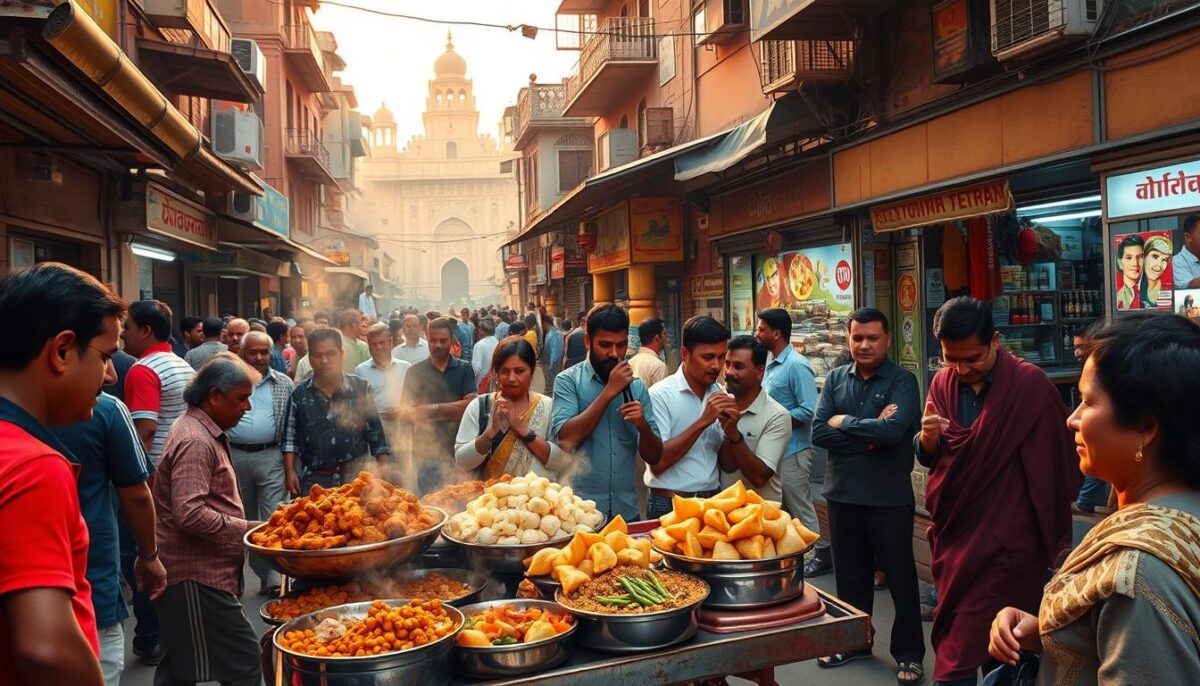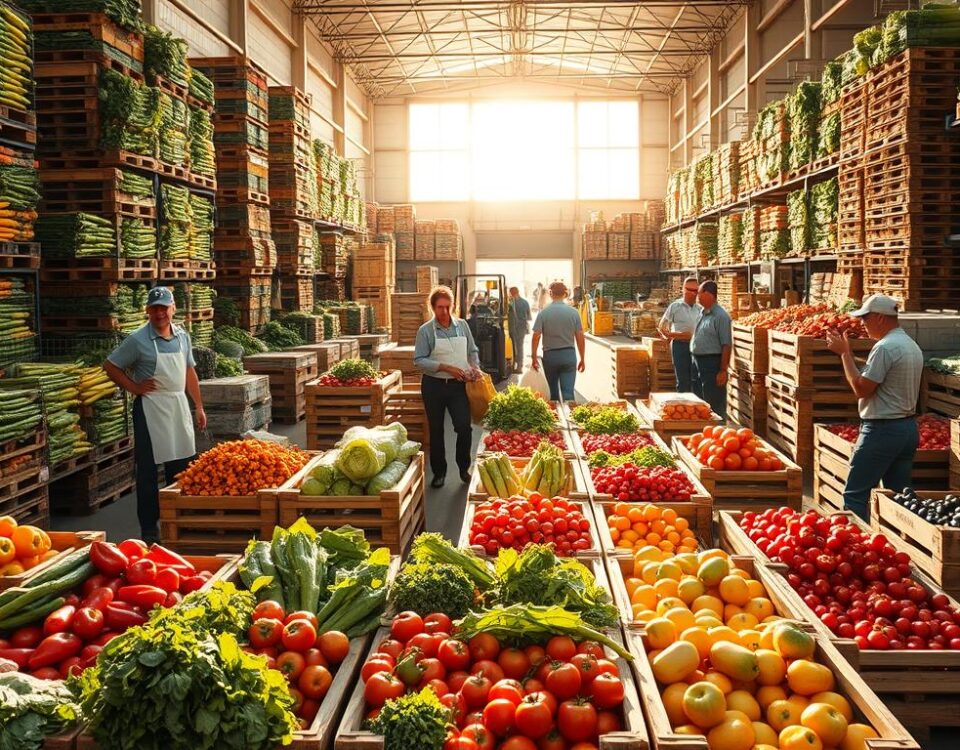
What to Eat in Los Angeles If You Want More Than Fast Food
June 9, 2025
5 Essential Stops for a Food Lover Visiting Mexico City
June 9, 2025Did you know that over 10,000 vendors serve up mouthwatering bites daily across India’s capital? My first taste of this culinary wonderland came during a monsoon evening in Chandni Chowk. Rain dripped off ancient awnings as I bit into a crispy aloo tikki – its spicy, tangy, and sweet notes exploding like fireworks. That moment hooked me forever.
From buttery parathas tucked in narrow lanes to smoky kebabs sizzling under neon signs, every corner here tells a story. I’ve spent years chasing these bold flavor adventures, discovering how generations-old recipes thrive beside modern twists. The energy is contagious – vendors calling out orders, spices perfuming the air, and locals debating the best chaat spots.
You don’t need a plane ticket to dive into this world. With the right know-how, anyone can recreate that sensory magic at home. Let’s unpack the secrets behind these iconic dishes and how they capture the city’s soul.
Key Takeaways
- India’s capital offers one of the world’s most diverse culinary scenes, blending tradition and innovation
- Iconic dishes balance spicy, tangy, and sweet profiles for unforgettable taste experiences
- Historic areas like Chandni Chowk provide authentic insights into local food culture
- Many street-style recipes can be adapted for home kitchens, even thousands of miles away
- Seasonal ingredients and expert spice blends are key to replicating authentic flavors
Embracing the Rich History Behind Delhi Street Food
The aroma of saffron-infused kebabs wafting through Old Delhi’s lanes isn’t just tempting—it’s a centuries-old culinary legacy. I once watched a vendor layer flaky parathas with the same precision shown in Mughal miniature paintings, realizing how deeply food and history intertwine here.
Historic Influences and Mughlai Heritage
Mughal emperors left more than monuments—they shaped the city’s culinary DNA. Their royal kitchens blended Persian nuts with local spices, creating rich gravies still used in kormas today. A 17th-century cookbook I studied revealed shockingly similar spice ratios to modern street carts.
From Royal Kitchens to Bustling Streets
When empires fell, skilled bawarchis (chefs) brought royal recipes to the people. I met fourth-generation vendors near Jama Masjid who still use hand-ground masalas from handwritten family journals. Their secret? Adapting elaborate dishes for quick service without losing essence.
| Era | Culinary Contribution | Modern Adaptation |
|---|---|---|
| Mughal Period | Slow-cooked meat dishes | Street-side nihari stews |
| British Raj | Tea culture | Kulhad chai in clay cups |
| Post-Independence | Regional migration | Hybrid dishes like chole kulche |
Today’s sizzling griddles carry whispers of banquet halls. That chaat you’re crunching? It’s democracy on a plate—once exclusive, now everyone’s shared heritage.
Discover Delhi street food flavors
Crispy, tangy, smoky—each bite here tells a story older than the spice routes. My first encounter with Golgappe involved a vendor deftly cracking fried shells and filling them with tamarind water. The explosion of sweet, spicy, and sour notes made me understand why this dish tops every must-try list.
Iconic Dishes You Must Try
Three creations define the city’s culinary identity. Chole Bhature pairs fluffy fried bread with chickpeas simmered in ginger-garlic gravy—a hearty breakfast staple. For texture contrast, nothing beats Aloo Tikki: crispy potato patties topped with yogurt and chutneys. Don’t miss skewers of seekh kebabs, their smokiness from charcoal grills unmatched by home ovens.
![]()
Signature Spices and Local Ingredients
What makes these dishes unforgettable? Amchur (dried mango powder) adds tanginess to chaats, while chaat masala—a blend of cumin and black salt—lifts every flavor. Vendors in Paranthe Wali Gali use stone-ground wheat for flaky layers, proving ingredient quality matters as much as technique.
Pro tip: Notice how vendors layer flavors. A perfect Aloo Tikki balances soft insides with crunchy exteriors, while Golgappe relies on chilled mint water to cut through heat. These details transform simple ingredients into magic.
Navigating the Best Street Food Spots Like a Local
Finding the perfect bite in India’s capital requires equal parts curiosity and strategy. I learned this dodging rickshaws near Jama Masjid, following my nose toward sizzling griddles where delhi street legends are born.
Chandni Chowk and Old Delhi Experiences
Morning light filters through spice sacks at Chawri Bazaar as vendors roll out parathas stuffed with seasonal fillings. The real magic happens near Gali Paranthe Wali – a narrow lane where paranthe wali masters have perfected stuffed bread since the 1870s. Pro tip: Arrive before noon to beat crowds and watch cooks layer dough with precision.
Hidden Gems in Vibrant Local Markets
South Delhi’s Lajpat Nagar reveals surprises for night owls. Behind the main streets delhi tourists frequent, I found a cart serving rajma chawal so creamy it rivaled five-star versions. Look for these signs of quality: ingredients prepped fresh onsite, locals queuing patiently, and vendors who smile while working lightning-fast.
| Location | Must-Try Item | Local Tip |
|---|---|---|
| Chandni Chowk | Daulat Ki Chaat | Best enjoyed pre-sunrise |
| Paranthe Wali Gali | Methi Paratha | Pair with tamarind chutney |
| Lajpat Nagar Central Market | Kulfi Falooda | Follow the jingle of spoon carts |
My golden rule? Let steam guide you. Stalls simmering pots of food delhi regulars crave often hide in plain sight. One detour near Fatehpuri Masjid led me to kadhi chawal so comforting, I still dream about its yogurt gravy.
A Personal Guide to Tasting and Enjoying Authentic Street Food
My most vivid memory involves balancing a steaming plate of chole bhature while perched on a wobbly stool. That golden bhature tore open to reveal fluffy layers, its chickpea curry singing with ginger and pomegranate seeds. Moments like these taught me how to savor every bite safely and joyfully.

Tips for a Safe and Flavorful Experience
Follow the locals. Busy stalls mean fresh ingredients and quick turnover. I always watch vendors prepare my meal – their rhythmic chopping of mint for chutneys signals quality. Hydrate with sealed bottled water, and carry digestive tablets if trying new spices.
One vendor near Jama Masjid taught me his secret: “Taste the chutney first – if it tingles your tongue, the dish will shine.” This trick helps balance heat levels before diving into fiery chole bhature or tangy pani puri.
Blending Tradition with Modern Culinary Twists
Young food enthusiasts are reimagining classics. I recently tried gulab jamun stuffed with dark chocolate – a dessert revolution honoring tradition while courting new palates. Even classic mint chutney now sees avocado blends in trendy markets.
My perfect meal? Crispy bhature paired with smoked eggplant dip – a modern twist that keeps me returning to a particular stall. Their innovation proves street eats evolve without losing soul. As twilight falls, join locals debating the best dessert carts. That shared excitement transforms eating into an experience.
Conclusion
Every bite here feels like unwrapping layers of history and innovation. From smoky meat kebabs to golden potato patties, each dish carries generations of craft. My journey through bustling markets revealed how chickpeas transform into hearty breakfasts, while milk-based desserts cool fiery palates.
What stays with me? The magic of combination. Paneer-stuffed breads meet tangy yogurt sauces, creating harmony on a plate. Meat lovers and vegetarians alike find joy in this culinary democracy.
Exploring these tastes taught me that food isn’t just eaten—it’s experienced. Whether reinventing recipes or honoring tradition, every creation whispers stories of heritage. To fellow flavor seekers: dive in. Let your kitchen echo with sizzling spices and shared memories.
FAQ
What makes Mughlai cuisine such a big part of the local food scene here?
I’ve always been fascinated by how Mughlai dishes like kebabs and rich curries reflect centuries of royal recipes. The use of saffron, dried fruits, and slow-cooked meats ties directly to the opulent kitchens of the past, creating a unique blend of heritage and flavor you can still taste today.
Which spots should I prioritize if I’m short on time?
Don’t miss Chandni Chowk’s paranthe wali gali for stuffed flatbreads or stalls near Jama Masjid for melt-in-your-mouth kebabs. For something sweet, head to Old Delhi’s iconic jalebi stands—their crispy, syrup-soaked spirals are worth every calorie!
How do I balance trying new things with staying safe?
I stick to busy stalls where high turnover means fresher ingredients. Avoid raw veggies washed in tap water, and opt for cooked dishes like aloo tikki or steaming bowls of chole bhature. Carry digestive tablets just in case—your stomach will thank you later.
Are there vegetarian-friendly options beyond the usual paneer dishes?
Absolutely! Try the chickpea-based chaat topped with tangy tamarind chutney or crispy samosas paired with mint yogurt dip. Many street vendors also serve delicious lentil-stuffed parathas or spiced potato rolls wrapped in soft bread.
What’s a must-try dessert that isn’t too heavy?
Grab a cup of rabri—a chilled, cardamom-infused milk pudding—or try the lighter phirni made with ground rice and rosewater. Both offer a sweet finish without overwhelming your palate after a savory meal.
Can I find modern twists on classic recipes in these markets?
Yes! Some vendors now add cheese to their chole bhature or serve fusion chaat with avocado. But don’t skip the classics—their timeless combinations of spices and textures are what make this cuisine unforgettable.



